Link building is one of those SEO tactics everyone talks about, but few really know how to measure.
If you’re investing in link building, you might wonder, “is this actually working?”.
You’re not alone.
Many businesses invest in link building without understanding its impact or having clear goals.
That’s what we tackle in this guide. It’ll help you set up and track effective link building metrics, and optimize performance on the go.
Do you need link building in 2025?
Before we dive in, let’s address the elephant in the room.
You’ve probably heard that traditional outreach methods that worked wonders some years ago now fall flat.
So, is link building even worth the effort anymore?
Absolutely.
Backlinks are essential for SEO. And this isn’t changing anytime soon.
If anything, they’re getting even more important.
With AI content flooding the internet, search engines need external authority signals to differentiate high-quality content.
For example, Flying Cat’s 2024 report revealed a strong link between off-page SEO strategies and improved traffic. Only 53% of the research’s respondents claimed to use digital PR. However, 72% of those using it saw traffic increases.
Another study found that while 95% of pages have zero backlinks, pages ranking #1 average 3.8 times more backlinks than those in positions 2-10.
Now, let’s see how you can set up your link building goals and measure success.
How to measure link building success step-by-step
Below, I’ll share a workflow for making your link building strategy more data-driven and structured.
1. Think about your overall goals
Before diving into specific link building metrics, step back and consider your broader business objectives.
What are you really trying to achieve with link building?
Remember, it’s not a standalone solution.
There are companies that invest heavily in building links without giving proper attention to their content strategy. But this approach is fundamentally flawed.
No SEO or content marketing tactic can work on its own without having other elements in place. Authority signals like backlinks are just one of the ranking factors, and they alone can’t give your website the boost it needs.
For example, quality content has much higher chances of attracting relevant backlinks. According to Semrush’s report, improving content quality is the second most successful tactic for boosting rankings—alongside posting more often.
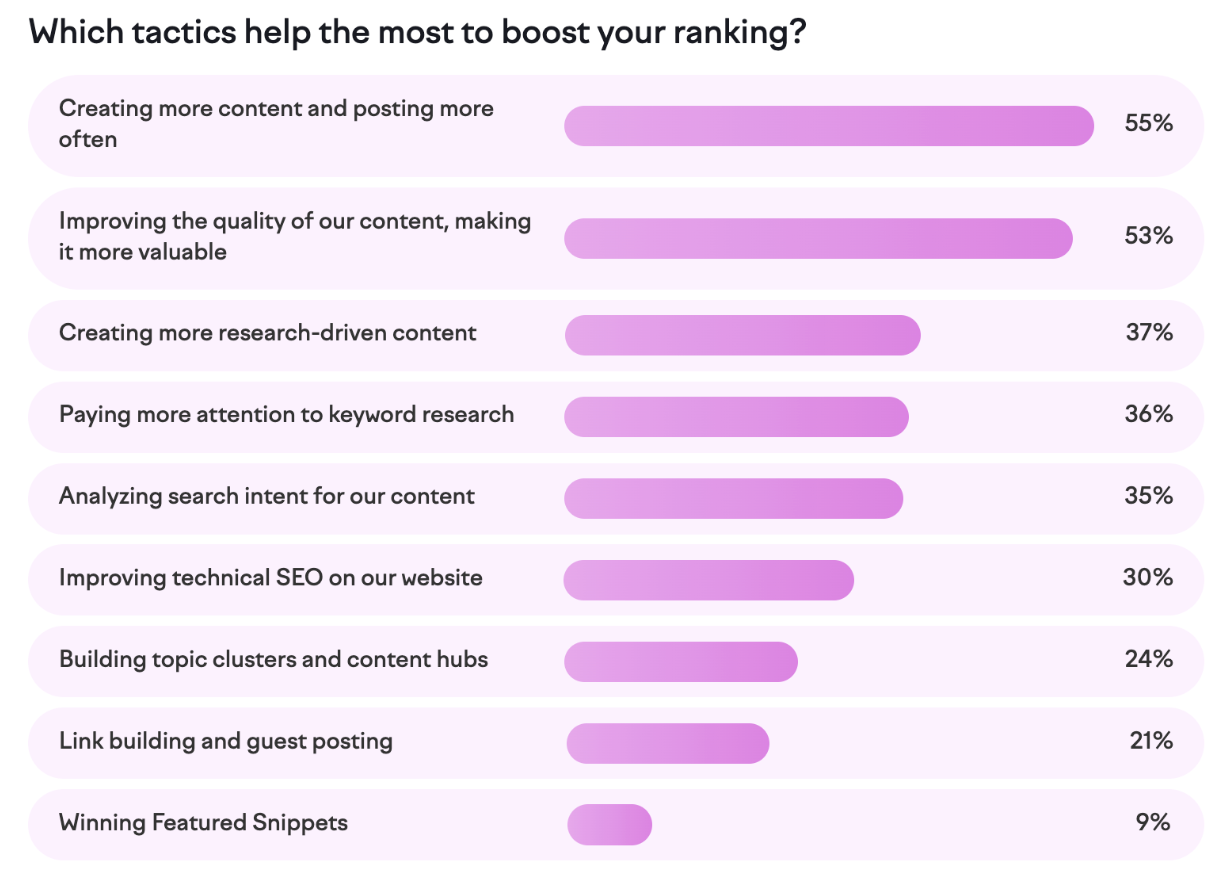
So, use link building as a part of your bigger content and SEO strategy—not as an isolated activity.
Here are various goals you can pursue when building links:
- Improved search rankings for specific pages
- Increased organic traffic
- Enhanced brand visibility and authority in your industry
- Potential for referral traffic from high-quality sites
However, for link building to effectively contribute to these outcomes, you need a solid foundation in place. This includes:
- High-quality, relevant content that provides value to your audience
- A technically sound website
- Clear site structure with strategic internal linking
- Optimized on-page elements
Without these fundamentals, even the most aggressive link building campaign will struggle to deliver meaningful results.
2. Define the scope and focus area
Are you looking to build links for a specific campaign, or as an ongoing effort to grow your authority? Answering this question will be your starting point.
For example, you could prioritize link building for:
- Competitive pages struggling to reach the top 3 positions despite solid on-page SEO and high-quality content
- Pages with lost or plateauing keyword rankings
- Brand building initiatives
- Supporting newly published, high-value content
- Growing important money pages
- Promoting research-driven content
Next, conduct research to estimate your overall targets and find benchmarks.
Here’s how you can go about it:
🚀Conduct competitor analysis.
Check how many backlinks your competitors have, both for their domain and key pages.
This gives you a benchmark to aim for.
It can also help you find link opportunities. If a website linked back to your competitor, perhaps they could get interested in your content?
For example, if a blogger wrote an article listing the top tools (say, for web hosting), you could reach out and suggest including your product too.
Use SEO platforms like Semrush to find this info. Input your competitor’s domain or a specific URL in the Backlink Analytics tool to see the backlink profile of any competitor.
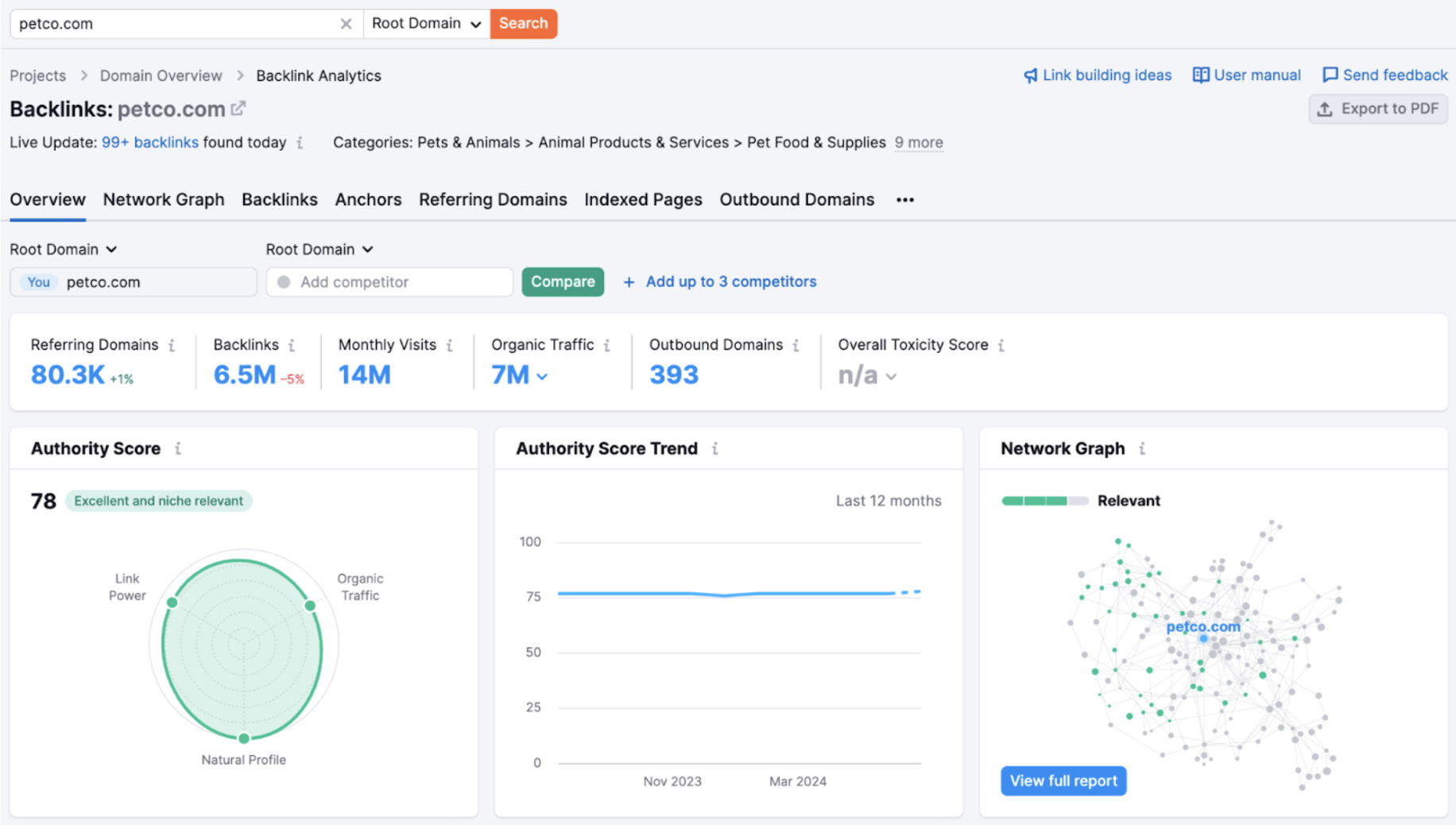
You can also check pages that attract the most backlinks by heading to the Indexed Pages tab.

Based on this data, you can roughly estimate the number of referring domains and backlinks you’d need to match your competitors.
🚀Check how many backlinks you need to rank for a specific keyword.
Are you after a specific keyword?
Check the top 10 pages already ranking for it and estimate the average number of links you should aim for.
Head to the Keyword Manager tool, enter your keyword and scroll down to see the number of referring domains and pages for each of your rivals.
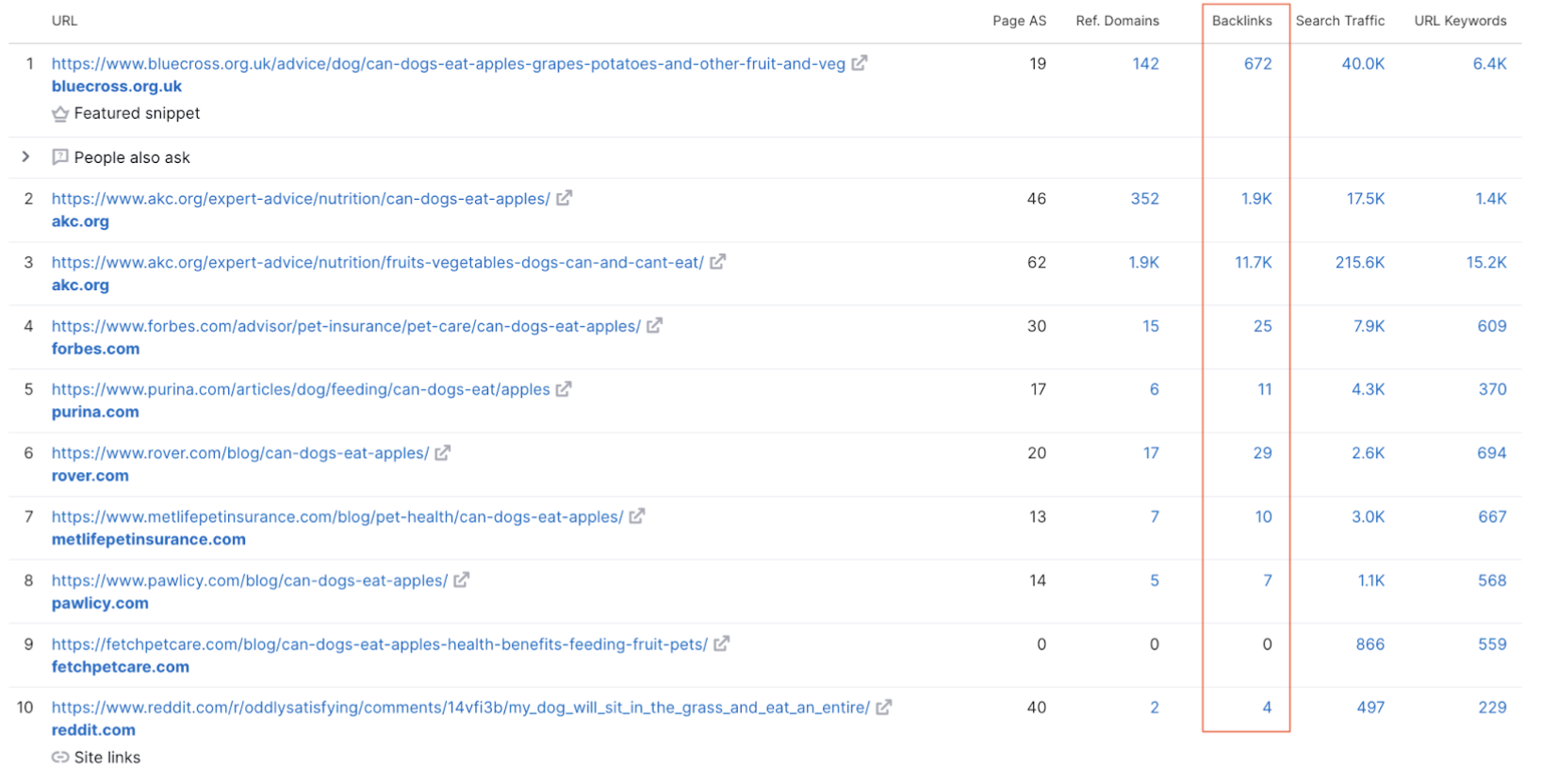
The Keyword Difficulty metric will also specify the average number of referring domains required to rank for your target keyword.
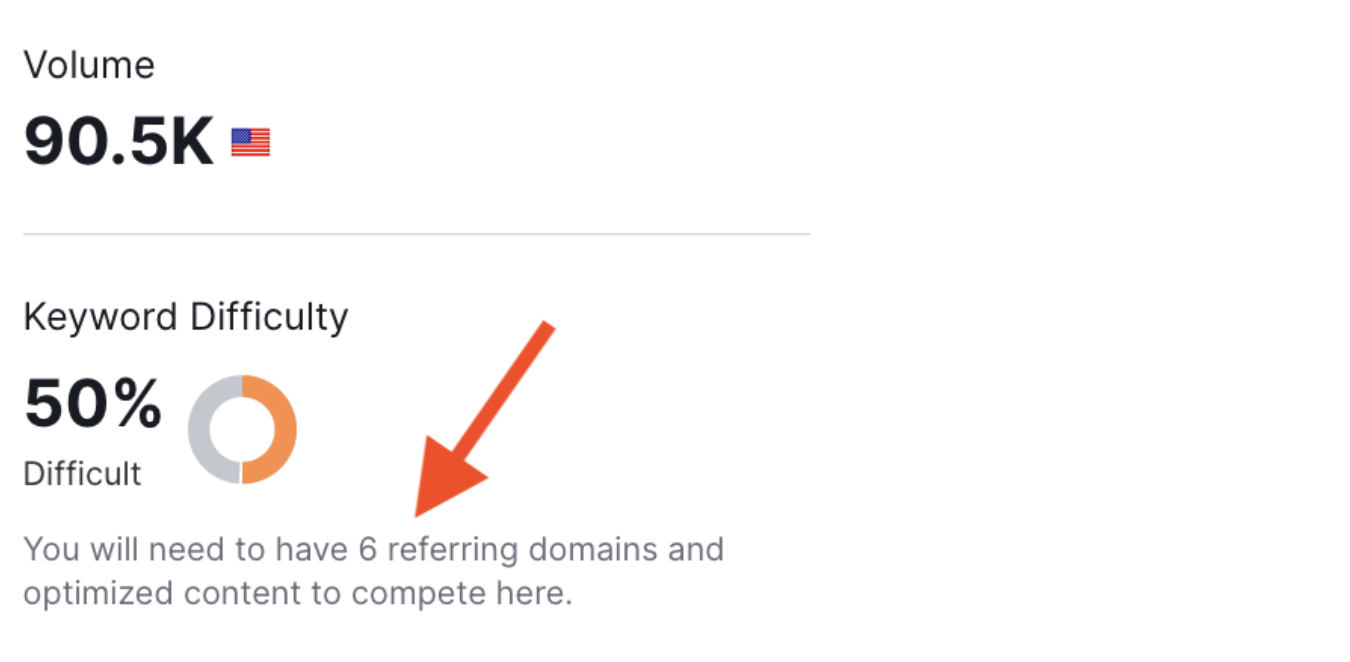
💡Remember, the dependence between backlinks and ranking is not always linear, and those numbers are not precise. It’s an estimation created using certain algorithms.
So, while you can use competitive analysis to set some benchmarks, it can’t be the one and only source of truth.
🚀Consider your optimal budget.
Given your current marketing budget, how much could you channel to link building?
Start by getting a rough idea of your available resources and then ask for specific quotes.
Most trustworthy agencies will charge anywhere from $300 – $1,000 per link. Anything much lower? Probably not worth your time if you want quality.
You can also do link building in-house. This approach will take you more time and effort, but will also save your resources.
There are many strategies you can use, including digital PR through writer forums, creating linkable assets, etc. (more on that below).
For example, Datis Mohsenipour from Outback Team Building & Training shared how his team increased the number of unique referring sites by 40% using link building communities.
Remember, link building is a long-term investment in your site’s authority. While it’s crucial for SEO, it doesn’t always generate direct, immediate ROI.
Budget accordingly, viewing it as a strategic investment rather than a quick win tactic.
3. List specific link building metrics
Now it’s time to define specific link building KPIs.
Here’s what you can track:
- Number of new backlinks per month or campaign
- Number of new referring domains
- Quality of linking sites (relevance to your niche, authority)
- Anchor text distribution
💡 A word of caution: Many people obsess over growing their Domain Authority (DA).
While this metric can provide some insight, it shouldn’t be your primary focus.
Here’s why:
DA is a third-party metric that is not one of Google’s ranking factors.
Investing heavily in increasing these scores often has little impact on your actual goals like qualified traffic or revenue.
I’ve seen businesses pour a lot of time and money into increasing their DA—only to find out that their real metrics (the ones affecting bottom line) haven’t improved at all.
DA is a leading indicator, at best, not the end goal.
You should keep it in mind while prioritizing KPIs that directly contribute to your company’s growth, such as driving qualified traffic and revenue.
4. Assess the quality and relevance of your backlinks
Remember, it’s not just about the numbers – the quality and relevance of your links are equally, if not more, important.
To assess the quality of a backlink, look at:
- Domain authority of the referring domain
- Page authority of the referring page
- Page-level traffic: Recent observations suggest that Google may value links from pages (not just domains) with higher traffic.
- Topical relevance: e.g., if you work in healthcare, relevant backlinks should come from other sites in the same industry or in a related one
- Referral traffic it generates
- Whether it’s coming from a spammy website
To summarize, you should be after links from authoritative and legitimate websites relevant to your business and your niche.
You can check each link’s quality using the same tool—Backlink Analytics. Input a URL or a domain and check the key details about the referring website.
Look at the authority scores of the domain, and the page and the URL’s niche relevance.
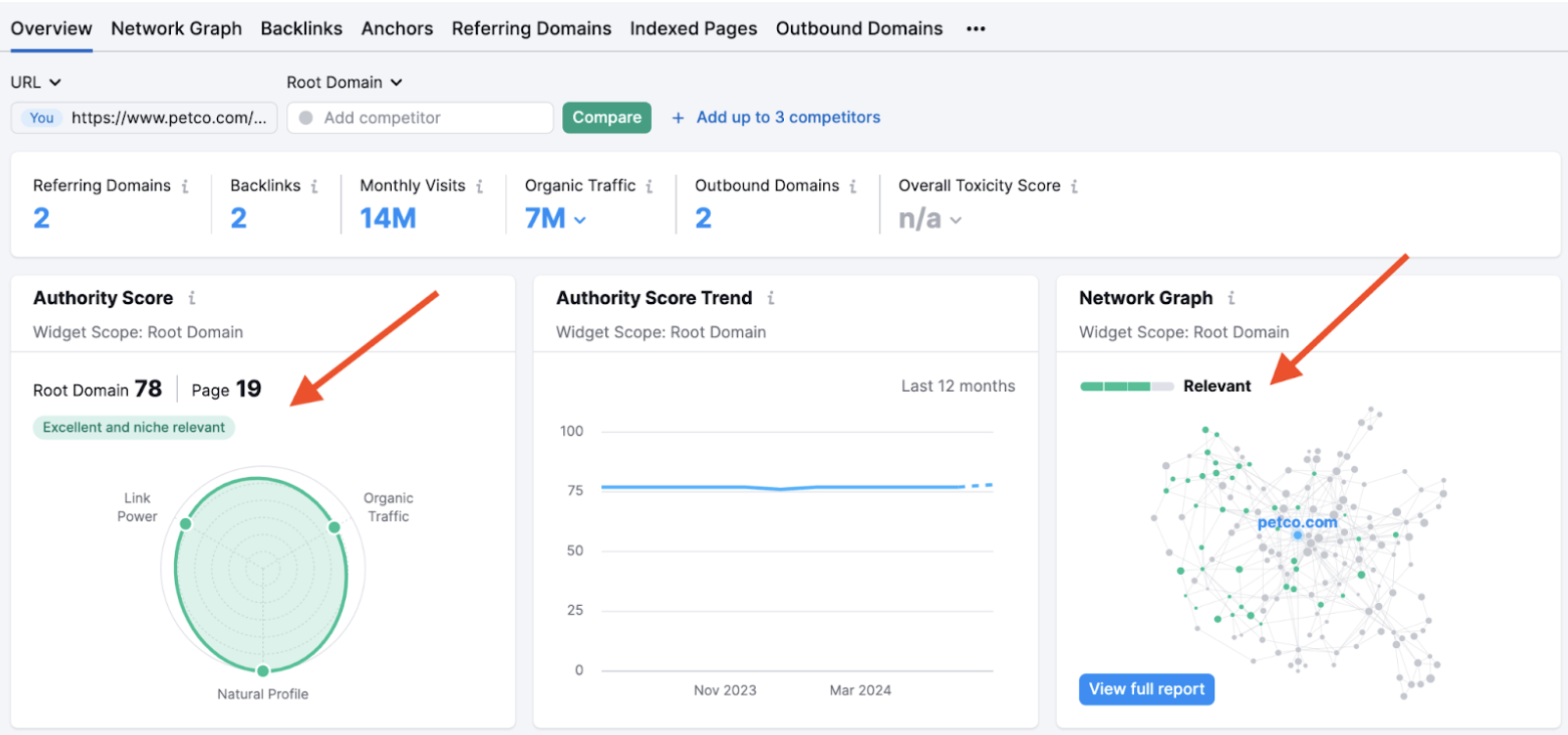
It’s also a good idea to analyze your overall backlink profile over time. Work on:
- Diversity of linking domains: A healthy profile has links from many unique domains, not just multiple links from a few sites.
- Link growth over time: Sudden spikes in link acquisition can look unnatural to search engines.
- Anchor text distribution: A natural profile has a mix of branded, non-branded, and relevant keyword anchor texts. Too many exact-match keyword anchors can appear manipulative.
- Link types: Do-follow links pass the link juice to your website, while no-follow links bear no SEO value. Natural-looking profiles usually have a combination of those.
- Topical relevance: Ensure most of your links are coming from sites relevant to your industry or niche.
Check your backlink profile using the Backlink Audit tool, which will generate a backlink toxicity score for your site. Look at the overall score, the types of backlinks you have, etc.
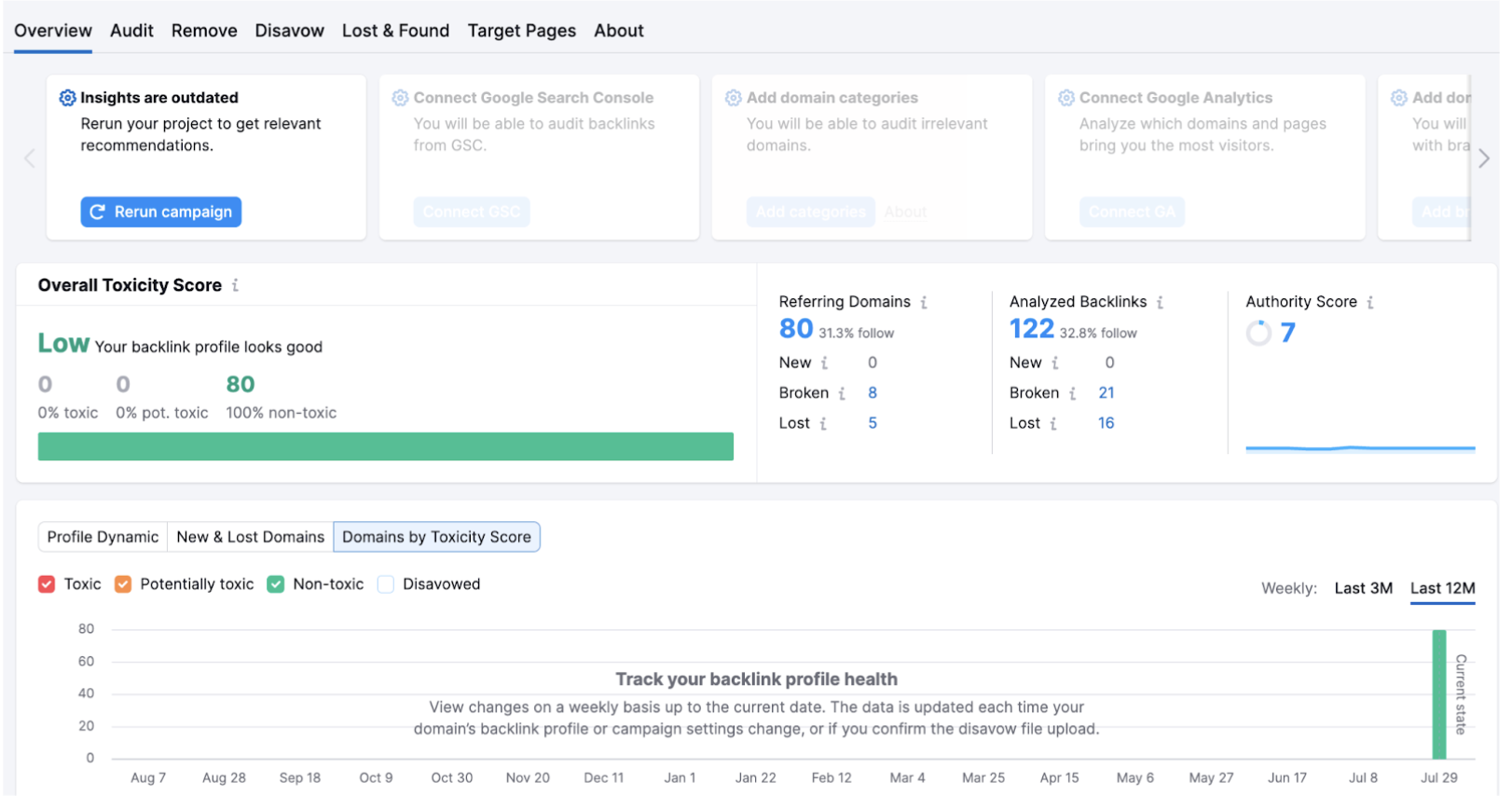
That being said, very few links that normal businesses receive are actually toxic.
Yes, you need a diverse and naturally-looking backlink profile to get positive results.
However, there’s also little value in disavowing (removing) backlinks unless you have a manual penalty by Google’s human reviewers.
5. Find out if link building is moving the needle
Now, the most interesting part: checking if link building is actually improving your SEO performance.
Here’s what you should look at:
🚀Ranking improvements for linked pages.
Track keyword rankings for specific pages that have acquired new backlinks. Look for positive changes in their positions on SERPs.
Analyze the timing of ranking improvements relative to when new backlinks were acquired to spot any correlation.
Ask yourself:
- Are rankings improving for pages that are acquiring backlinks? Is there a correlation between new backlinks and ranking changes?
- Are you noticing faster ranking improvements and achieving higher SERP positions for pages with new backlinks?
You can also use Google Search Console to monitor your rankings for each specific page. Go to Performance → Search results → add filters to select the target URL(s).
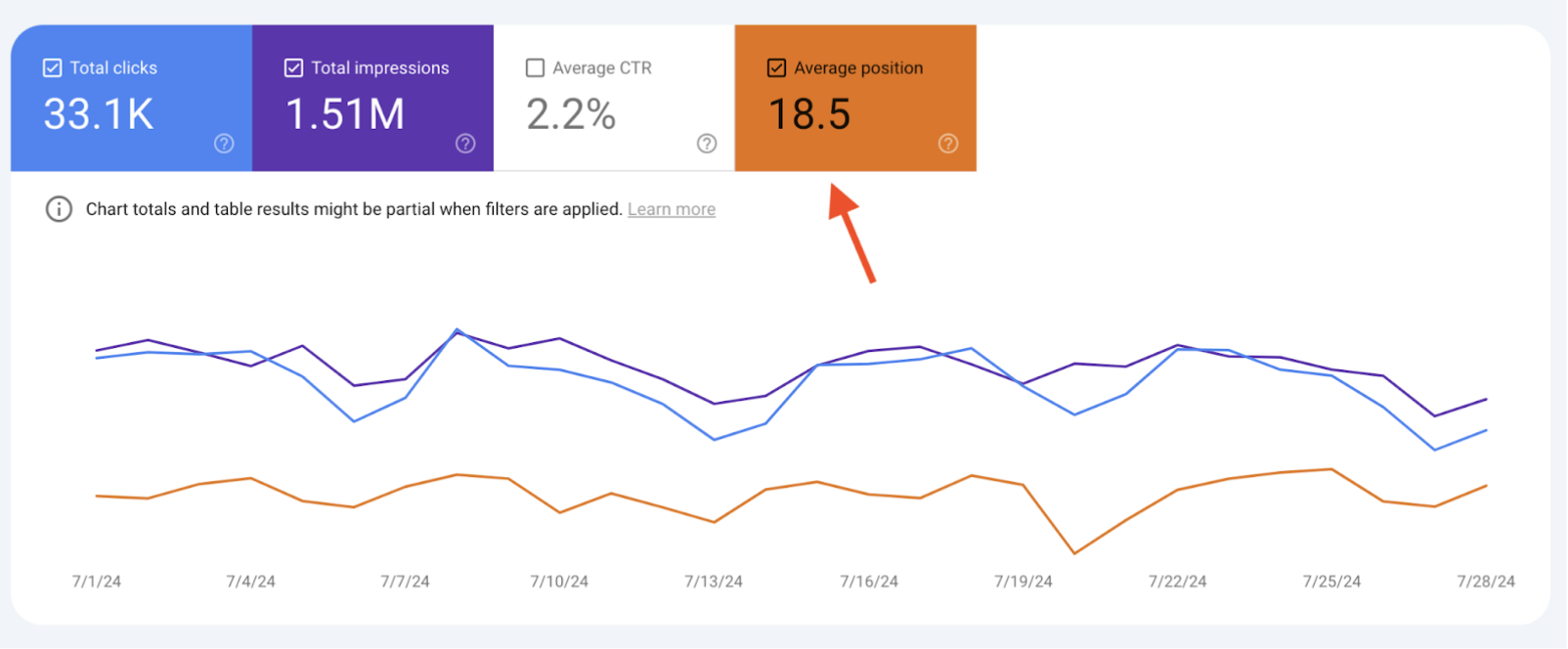
🚀Organic and referral traffic growth.
Next, look at changes in organic traffic.
An uptick in traffic, especially from relevant keywords, can signal that your link building is paying off.
To do it, head to Google Search Console and check the number of clicks your web pages receive from SERPs.

It’s also a good idea to assess whether your backlinks generate referral traffic for your website.
Head to Google Analytics 4 (GA4) and navigate to Reports > Acquisition > Traffic acquisition.
From here, type the domain of the referring site in the search bar to check whether it’s bringing you any traffic.
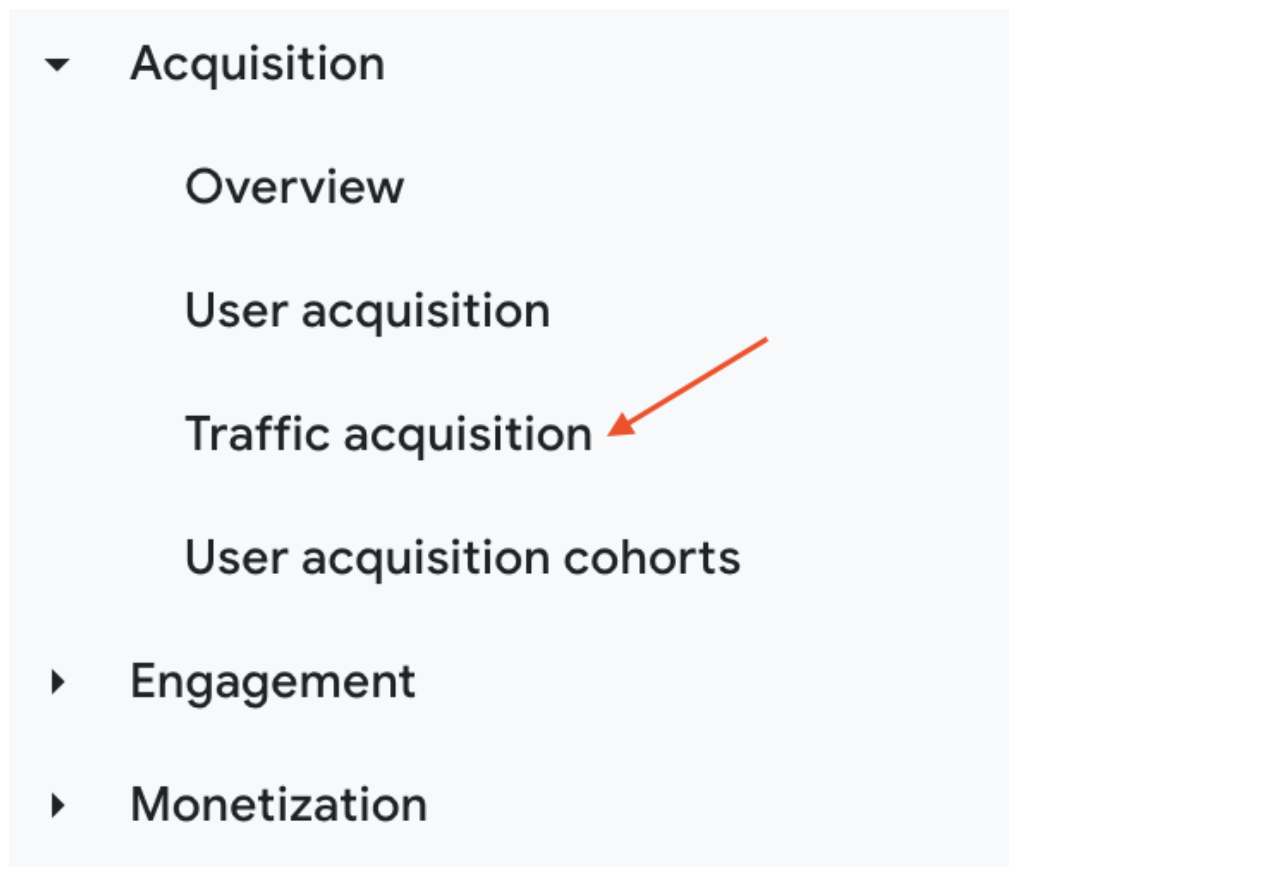
You can also check traffic sources for a specific page. Go to Engagement > Pages and screens.
Use the search bar to find specific pages. Then, click the “+” icon to add a dimension and select Session source/medium.
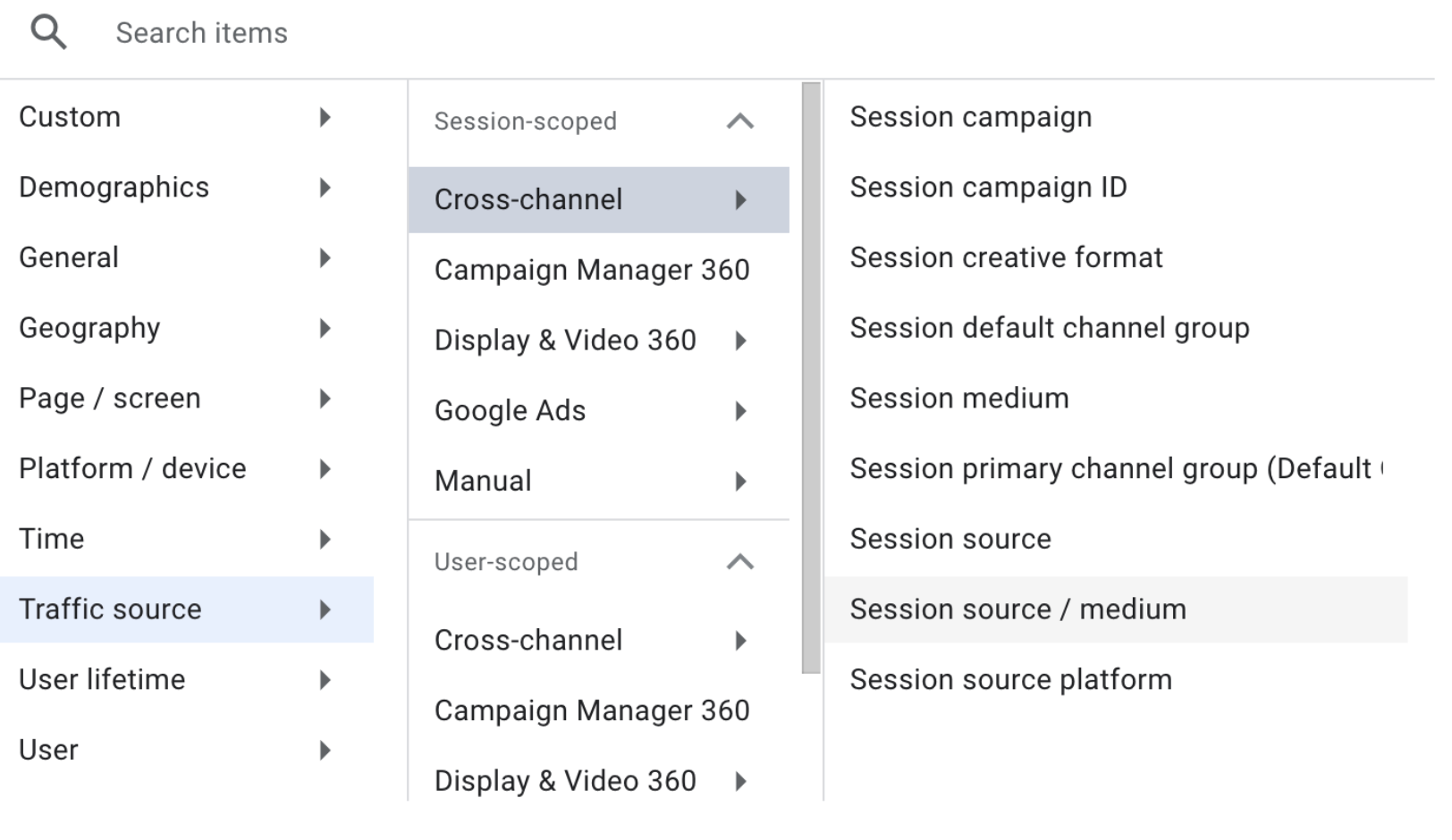
🚀Domain authority trends.
Domain Authority should not be your key goal and the foundational metric to track.
However, a gradual increase over time can indicate growing site authority. Which can be achieved through your link-building efforts.
It’s not an official metric used by Google—platforms like Semrush develop it to help site owners track their growth.
The higher your DA, the easier it gets to rank in search engines (given that you create relevant and quality content).
To monitor your DA, you’ll also need a specialized tool.
Head to Semrush’s Domain Overview tool and input your domain to check your DA. You can do the same with your competitors’ domains.

Finally, it’s important to have patience and let the effect of your efforts build up.
Just like anything else in SEO, link building takes time.
Here’s an approximate timeline you could expect:
- Short-term (1-3 months): You might see some initial movement in rankings and possibly some referral traffic.
- Medium-term (3-6 months): More noticeable improvements in rankings and organic traffic should become apparent.
- Long-term (6+ months): The full impact of your link building efforts should be evident, with sustained ranking improvements and traffic growth.
Monitor if ranking improvements and traffic gains are sustained over time.
Remember, link building is part of a larger SEO strategy.
If you’re seeing positive movement, it’s likely due to a combination of factors, including your content quality, on-page optimization, and overall site health.
And if you’re not seeing the needle move despite acquiring quality links, it might be time to re-evaluate other aspects of your SEO strategy.
How to achieve success with link building
Before we wrap it up, here’s a little bonus for you. Let’s look at the key tactics for effective link building in 2025.
1. Stick to white-hat SEO practices
This goes without saying.
Avoid buying links or engaging in other black-hat techniques.
While these might seem like quick wins, they can lead to penalties from search engines, damaging your long-term SEO efforts. Or, most probably, they simply won’t generate any ROI.
Instead, focus on earning links through valuable content and genuine relationships.
And what about link exchanges?
By default, all link exchanges go against Google’s guidelines.
However, small-scale and rather natural exchanges are not likely to hurt your rankings.
That being said, it’s not recommended as a scalable business strategy.
For example, having lots of mutual links with the same website is suspicious and less effective than having links from different domains.
2. Create linkable assets
Developing content that naturally attracts links is the best strategy out there.
For example, generating links for a product page can get really tough. But it’s quite different for a research-driven content piece. You can then add internal linking and pass rank to the product page.
Such link-worthy content could include:
- Original research, experiments, or studies
- Comprehensive guides or resources
- Infographics or data visualizations
- Tools or calculators relevant to your industry
- Lists of relevant industry statistics
- Strong opinion pieces
- Guides providing definitions to various concepts
For example, HubSpot’s State of Marketing report generated over 136K backlinks over the past few years. It’s a powerful content piece that serves as an evergreen link magnet.
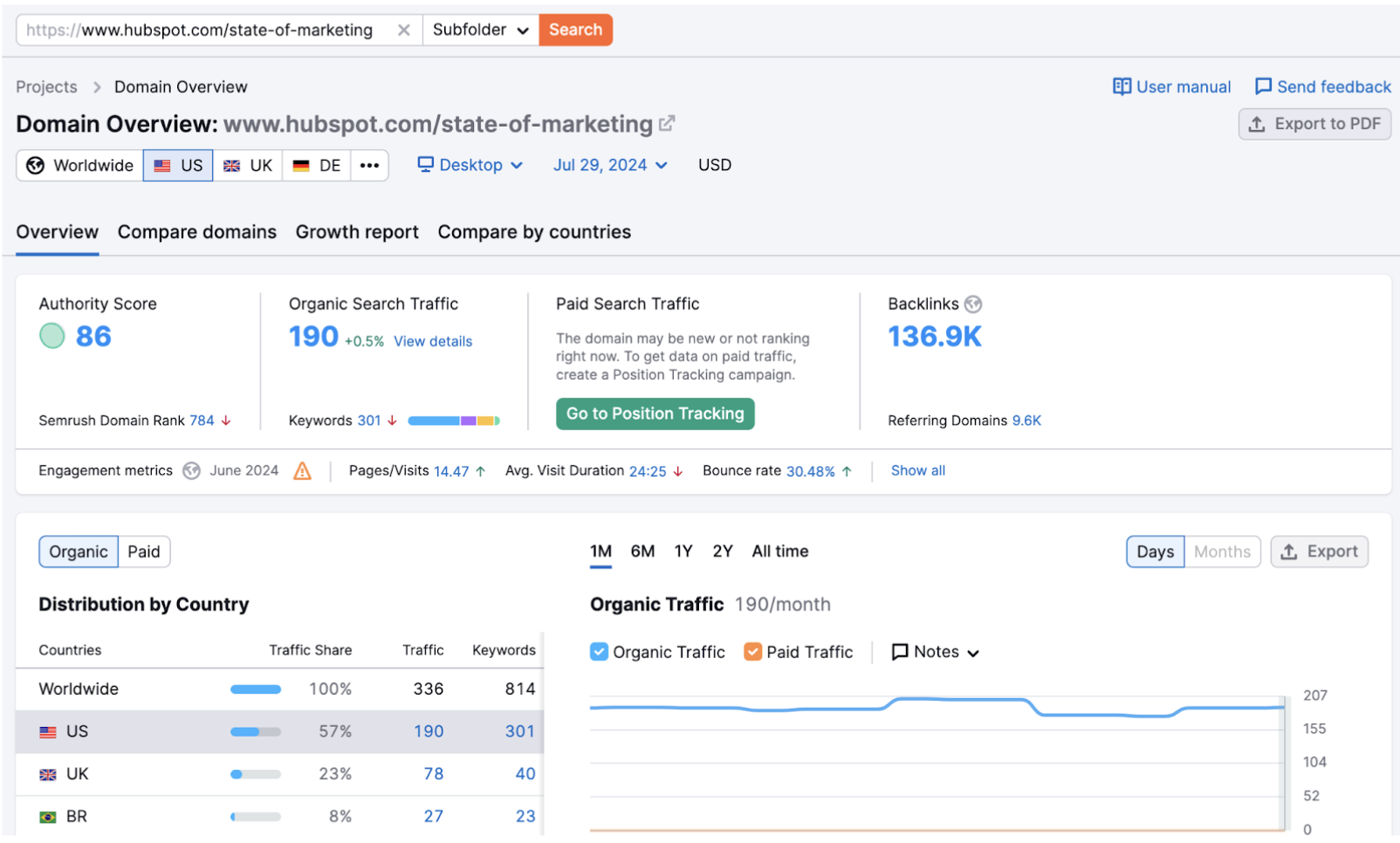
3. Conduct competitive analysis
Analyze your competitors’ backlink profiles to find link opportunities and understand what type of content is attracting links in your niche.
For example, after checking HubSpot’s backlink profile, we can conclude that some of the top content pieces are templates and long-form ultimate guides.
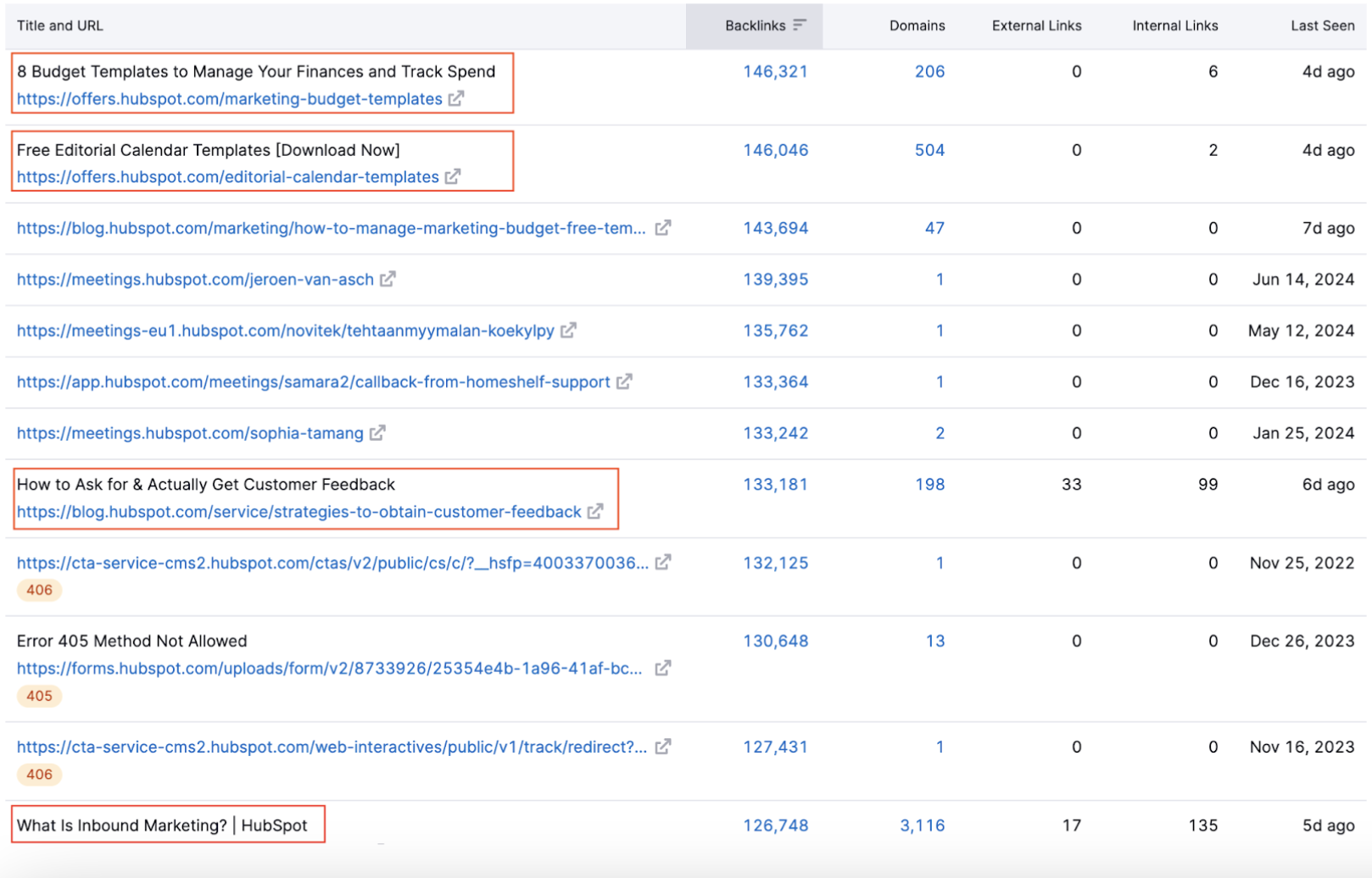
4. Leverage partnerships and collaborations
Engage in partnerships, contribute to others’ content, speak at events or on podcasts.
These activities can naturally lead to high-quality backlinks.For example, Semrush always invites industry’s leading experts to contribute to its State of Content Marketing report and links back to their websites.

5. Track your outreach efforts and optimize accordingly
Keep track of how many outreach emails you (or your specialist) are sending and the number of links you’re getting.
This will help you calculate your success rate and compare the effectiveness of different campaigns or types of content.
For example, you might notice that certain outreach templates or content pieces create more traction—and integrate this approach into your strategy. You can use tools like the Link Building Tool to save backlink prospects and track the outreach process.

6. Work with a trustworthy agency
If you lack the time or expertise, an SEO agency can help guide your link building efforts.
In reality, link building is a niche activity that requires specific experience. Outsourcing will almost always bring you higher ROI.
Look for an agency that:
- Views link building as a part of your overall content and SEO strategy
- Focuses on legitimate link building tactics
- Prioritizes creating value for your business
- Delivers high-quality links that will create a positive long-term impact for your site
This way, you can get the best possible results without breaking the bank. Take a look at our list of best niche-specific link building agencies for more.
Wrapping up
Measuring link building success is all about conducting research and tracking your overall SEO performance. Here are the key tips for doing it right:
- Align link building with your overall business and SEO goals.
- Focus on quality over quantity, prioritizing relevant and authoritative links.
- Track the impact on organic traffic, rankings, and referral traffic.
- Integrate link building with your broader content strategy.
- Hire an agency that can connect all these dots.
Remember, link building is a long-term investment that requires a smart approach.
